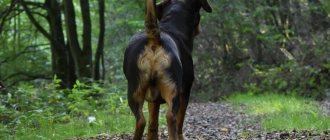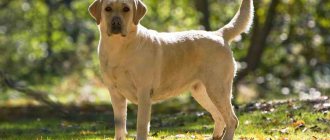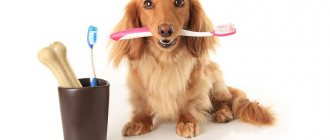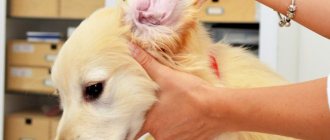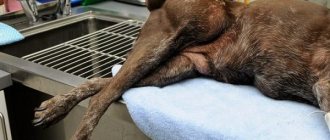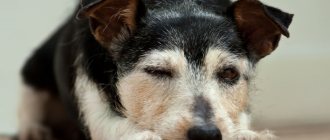Preface
Dogs, like many other animals, are susceptible to various diseases, including runny nose (rhinitis). A dog runny nose is an inflammation of the sinus lining. At the beginning of the disease, many owners do not notice the problem and perceive an overly wet nose as a common occurrence. At the same time, it is important to recognize rhinitis as quickly as possible in order to avoid a more complex course and subsequent complications.
To cure a runny nose, it is necessary to find the root cause of the disease, since nasal discharge can only be a symptom of something more serious. For example, this could be the beginning of a serious disease such as plague or inflammation of the larynx.
Symptoms of rhinitis
In addition to nasal discharge, canine rhinitis can be accompanied by other symptoms. These include :
- The animal's condition deteriorates sharply, the dog becomes inactive, lethargic, shows no interest in the environment, sleeps a lot, does not want to go for a walk, and even refuses food and water.
- In some cases, there is an increase in body temperature, and low-grade fever may also be elevated.
- Complete or partial refusal to eat, even his favorite treats do not arouse his interest.
The main symptoms of a runny nose:
- There is discharge from the nostrils, the discharge may be too liquid or, conversely, too viscous. The color can also vary from clear to dark marsh. Also, dry crusts or a small black coating appear around the nostrils.
- There is difficulty breathing, which can be heard from the side, the dog sniffles heavily in his sleep. A characteristic whistle, sniffling and snorting appears, the voice changes slightly and the sounds are similar to the sounds of someone with a cold.
- The animal begins to sneeze frequently and for a long time. This fact has nothing to do with dust and other irritants that can cause sneezing.
- Dryness of the nasopharynx appears, the dog often licks itself and tries to scratch its nose with its paw.
- Due to severe itching, the dog often begins to rub its muzzle against household items or the carpet.
All of the above symptoms indicate the manifestation of the classic form of a runny nose, however, if you do not pay attention to the primary signs in time, then the classic form can develop into something more complex.
If a dog’s usual runny nose is left to chance and not treated for a long time, then over time the animal will not be able to breathe normally. The lack of sufficient oxygen can cause oxygen starvation, which can have serious consequences.
How to treat a runny nose in a dog, please tell me..
Answers:
La Mur
Anandin - intranasal, i.e. drip into the nose and eyes. If it doesn't help, then run to the vet.
selena mystery of the night
inject fosprenil and gamavit once a day, 0.1 ml per 1 kg of weight. drip maxidin 0.015% or anandin into the nose. Lubricate your nose with oxolinic ointment. and solder with Vet 1.1.
maritime
First you need to eliminate the causes of rhinitis. it can occur due to inhalation of air containing dust, corrosive gases, mold, due to drafts, dampness and hypothermia, BUT it can also appear as a consequence of inadequate feeding, in particular vitamin deficiency. A. and be a symptom of infectious diseases!!! and here we also need to treat the underlying disease! well, to treat rhinitis, the nasal mucosa is irrigated with 0.25% novocaine solution, 2-3% boric acid solution, 3-5% baking soda solution, dogs can be instilled into the nostrils with 1% menthol solution in vegetable oil or fish oil. if there is an increase in temperature, then antibiotics are prescribed, but in this case it is definitely better to consult a doctor.
How to treat rhinitis in dogs?
10 (100%) 1 vote[s]
Rhinitis is an inflammation of the nasal mucosa. The nature of this inflammation can be quite different: catarrhal, hemorrhagic, lobar and follicular.
According to the course, acute and chronic rhinitis is distinguished, and by origin - primary and secondary. Catarrhal rhinitis occurs most often, mainly in the cold season.
Causes of a runny nose
Before starting therapy, it is necessary to establish the exact cause of the snot. In most cases, the causative agent is harmful microorganisms, viruses and bacteria. Also, congestion can be one of the symptoms of a common seasonal cold, during which opportunistic flora is activated. The most dangerous cause may be the canine distemper virus.
Sometimes the cause is an allergic reaction due to seasonal flowering, excessive dust in the area, household chemicals and even food. Allergic rhinitis poses a serious danger to the health of the animal and its life, as it can be fatal.
Sometimes snot appears against the background of a weakened immune system or some chronic disease. In addition, if vital internal organs suffer, then the entire body suffers. In such cases, symptomatic treatment of snot does not give a lasting result and it periodically returns again.
Parasites can also be the cause. With their presence, they irritate the nasal mucosa, as a result of which the disease develops. To eliminate it, you must first get rid of the parasites.
List of causes of runny nose in dogs:
- Bacterial and viral infections . If discharge from the nasal passages is caused by a virus or bacteria, then at first they have a transparent color. After a few days, the snot becomes yellow or slightly green, and there may also be some blood. Consistency ranges from very liquid to viscous. In addition, there is tearing, vomiting and diarrhea. The dog becomes lethargic and may refuse food and even his favorite treat. Dry crusts and cracks appear on the nose, heavy breathing is noted, the animal begins to breathe through the mouth, with its mouth slightly open.
- Foreign object in the nasal passage . Pets explore the world around them by relying on their sense of smell. It is not surprising that sometimes foreign objects get into the nasal passages, which can cause serious damage to the health and life of the animal. If the cause of the snot is a foreign object, then it will most likely flow only from one nostril; the dog may begin to sneeze, try to pick something out of its nose, and even shake its head.
- Allergic reaction . Quite often, the animal’s immune system perceives the environment as a threat and may react incorrectly to certain odors, dust, pollen from plants, new foods, cosmetics, etc. With allergic rhinitis, there is abundant clear discharge from the nose, swelling of the mucous membranes, and a cough may appear. discharge from the eyes. Sometimes diarrhea, nausea and vomiting appear.
- Reaction to strong smelling substances . Fragrant household perfume, the smell of gasoline, household chemicals, and even the usual smell of a fire can cause excessive mucus secretion from the nostrils. In this case, the dog begins to actively sneeze and tries to scratch his nose on foreign objects.
- Mechanical damage or congenital anomalies . Due to injury (fracture of the nose, jaw) or abnormal structure of the nasopharynx, the animal often has a runny nose, sometimes there are breathing problems, the dog snores loudly and breathes through its mouth.
- Neoplasms (polyps, tumors, cystic growths) . If problems of this kind are observed, then during a runny nose the dog will experience pain and difficulty breathing. In addition, she will sniffle and snort.
How to treat a runny nose in a dog
Answers:
Polyakova
We need to determine the cause, maybe it’s an allergy?
Maria Eremeeva
We washed it with furacelin, and also bought special drops from a pet store. Come there, they will advise you on drops for both the breed and the weight of the dog. By the way, you don't have to worry too much because it's a common flower allergy in dogs. They feel spring earlier than people, so you can also buy some herbal allergy pills
Levi
Depending on the diagnosis.
Alenka Alenkina
Dogs don't have allergies!!! !
Most likely, it is a viral disease; there is no need to treat it like a runny nose, it should be a comprehensive treatment prescribed by a doctor
Anastasia
You can use baby drops, and furatsilin will do
Alexander Rura
if viral rhinitis, then rinse with furatsilin and antibiotics biomycin 25 mg/kg body weight for a course of 5 days
Pskov woman
Marianna wrote it correctly. This is most likely a viral infection (the so-called canine flu). Depending on the dog’s immunity, it occurs in varying degrees of severity. Last spring our whole group of dogs got sick. Someone sneezed for a couple of days, and some ended up on a drip... But as it turned out, this rubbish also creates complications... It’s better not to self-medicate, but to visit a veterinary clinic, I think... I read about an allergy supplement... Then give the dog an antihistamine (such as Tavigil) and watch his nose. If the snot goes away, then your diagnosis is allergy... Look for the allergen... and eliminate...
Treatment
When the first symptoms of rhinitis appear, you must immediately seek help from a veterinary center; if this is not possible, then you can help your four-legged friend without leaving home.
Before visiting the veterinarian, you should do the following:
- Veterinarians allow owners to use nasal drops to eliminate harmful bacteria and microbes, for example, such as Anandin or Maxidin, before arriving at the clinic for examination. It is enough to drop 1-2 drops into each nostril. In addition to drops, rinsing with regular saline helps to clear the nasal passages. These actions will not bring any harm to the animal, as they have a mild effect on the tissue of the mucous membrane.
- You should carefully examine the dog's nasal passages using a small or telephone flashlight. If you find a foreign object, you should not try to remove it yourself, as you can damage the mucous membrane and cause even more harm. In addition, inept attempts can push the foreign body even deeper and thus complicate the surgeon’s work when going to the clinic.
- When a dog has a cold, it is not recommended to lie on drafts or too cold floors, as this can only aggravate the situation. In addition, you need to make sure that the dog avoids cold places in the future and is constantly warm.
- Contamination and leakage should be removed regularly using a gauze swab or cotton pad. In order not to injure your nose, you can pre-treat it with chamomile decoction or a special anti-inflammatory cream.
- During the period of illness, you should take care of proper nutrition. Food should be nourishing, tasty and familiar. It is not recommended to switch your dog to a different diet during illness.
- It is important to correctly assess the color of the discharge and check its uniformity, as well as consistency.
- It is important to provide your dog with constant warm water.
How to help your pet at home?
After studying the results of the study and making an accurate diagnosis, the veterinarian develops a treatment regimen. Usually, if surgery is not required when tumors or deformities are detected in the nasopharyngeal cavity, the four-legged patient is sent home for treatment. At home, the pet’s nose is washed and warmed, drops are instilled and medications are given. In addition to drug therapy, the dog requires special care and nutrition to speed up recovery.
Rinsing and warming the nose
Before you rinse your pet's nose, you need to clean it of crusts. To effectively clean the nasal passages, you need to use a cotton swab moistened with warm boiled water or hydrogen peroxide. They should then be washed. This is done using saline or nasal rinses for people, pre-warmed to the animal’s body temperature. Rinse the nasal passages with liquid from a small rubber bulb or syringe without a needle. When carrying out the manipulation, you need to ensure that the solution does not get into the pet’s mouth.
Prevention
To minimize the risk of developing colds and the development of rhinitis, the following recommendations must be followed :
- Minimize interaction with other animals . To protect your dog from various diseases, it is necessary to minimize its contact with suspicious animals that are often encountered while walking. You should be especially careful with street and stray animals.
- Quality food . The dog's diet must be balanced and correct. You should not give your pet low-quality products or low-grade food. In addition, it is important to constantly provide healthy vitamins, minerals and missing trace elements.
- Active lifestyle . To maintain a strong immune system, your dog should regularly spend time outdoors. Alleys should be frequent and long. An exception may be rainy and cold days.
- Avoiding hypothermia . Do not allow the animal to lie on drafts or cold floors. In winter, you should take care of warm clothes for your pet and, possibly, buy special boots.
- Vaccinations . It is important to follow the vaccination schedule and not skip annual vaccinations.
Prevention of respiratory viral diseases and timely diagnosis can significantly improve the animal’s quality of life and avoid serious problems.
Causes of rhinitis in dogs
Predisposition to rhinitis is due to violations in the feeding and maintenance of puppies and dogs. A decrease in the protective functions of the nasal mucosa to the effects of various unfavorable factors is facilitated by a lack of macro- and microelements, proteins, and vitamins, especially C and A, in the diet.
Dampness and constant drafts in dog rooms also reduce the body’s natural defenses. Rhinitis can also occur with sudden cooling of the body, rapid transitions from cold to heat and vice versa. Hot air, irritating substances, and smoke during a fire are dangerous for a dog’s nose. It is also possible that secondary rhinitis may occur against the background of an underlying infectious disease (or plague) or non-infectious disease (stomatitis, laryngitis, frontal sinusitis).

